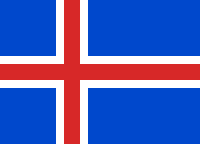Kingdom of Iceland
| Kingdom of Iceland | ||||||||||
| Konungsríkið Ísland | ||||||||||
| Personal union with Denmark | ||||||||||
| ||||||||||
| ||||||||||
| Anthem Lofsöngur | ||||||||||
.svg.png) The Kingdom of Iceland in 1942. | ||||||||||
| Capital | Reykjavík | |||||||||
| Languages | Icelandic, Danish | |||||||||
| Religion | Church of Iceland | |||||||||
| Government | Constitutional monarchy | |||||||||
| King | ||||||||||
| • | 1918–1944 | Kristján X | ||||||||
| Regent | ||||||||||
| • | 1941–1944 | Sveinn Björnsson | ||||||||
| Prime Minister | ||||||||||
| • | 1918–1920 | Jón Magnússon (first) | ||||||||
| • | 1942–1944 | Björn Þórðarson (last) | ||||||||
| Legislature | Althing | |||||||||
| Historical era | Interwar period / WWII | |||||||||
| • | Act of Union | 1 December 1918 | ||||||||
| • | Fall of Denmark | 9 April 1940 | ||||||||
| • | Operation Fork | 10 May 1940 | ||||||||
| • | National referendum | 20 May 1944 | ||||||||
| • | Republic proclaimed | 17 June 1944 | ||||||||
| Area | ||||||||||
| • | 1944 | 103,125 km² (39,817 sq mi) | ||||||||
| Population | ||||||||||
| • | 1944 est.[1] | 125,967 | ||||||||
| Density | 1.2 /km² (3.2 /sq mi) | |||||||||
| Currency | Króna | |||||||||
| ||||||||||
Part of a series on the |
||||||||||||||||||||||||
|---|---|---|---|---|---|---|---|---|---|---|---|---|---|---|---|---|---|---|---|---|---|---|---|---|
| History of Iceland | ||||||||||||||||||||||||
 | ||||||||||||||||||||||||
| Middle Ages | ||||||||||||||||||||||||
|
||||||||||||||||||||||||
| Modern era | ||||||||||||||||||||||||
|
||||||||||||||||||||||||
| Related topics | ||||||||||||||||||||||||
| Timeline | ||||||||||||||||||||||||
|
| ||||||||||||||||||||||||
The Kingdom of Iceland (Icelandic: Konungsríkið Ísland; Danish: Kongeriget Island) was a constitutional monarchy that existed through the Act of Union with Denmark signed on 1 December 1918.[2] It lasted until 17 June 1944 when a national referendum established the Republic of Iceland in its place.[3]
Origins of Danish rule
Iceland had been under the control of the Crown of Denmark since 1380, although formally it had been a Norwegian possession until 1814. In 1874, one thousand years after the first acknowledged settlement, Denmark granted Iceland home rule. The constitution, written the same year, was revised in 1903 and the extent of Iceland's home rule increased in 1904. A minister for Icelandic affairs, residing in Reykjavík, was made responsible to the Althing, the Icelandic parliament.
Establishment of the Kingdom
On 1 December 1918, the Act of Union, an agreement with Denmark, recognized Iceland as a fully sovereign state in personal union with Denmark through a common monarch. The Kingdom of Iceland established its own flag and coat of arms and asked that Denmark represent its foreign affairs and defence interests. The Act would be reviewed in 1940 and could be revoked three years later if agreement to continue it could not be reached.
World War II and the establishment of the Republic
The German occupation of Denmark on 9 April 1940 severed communications between Iceland and Denmark.[2] As a result, on 10 April, the Althing passed two resolutions investing the Icelandic cabinet with the power of head of state and declaring that Iceland would accept full responsibility for both foreign policy and coastal surveillance. A year later, on 15 May 1941 the Althing adopted a law creating the position of regent for Sveinn Björnsson in order to represent the monarchy.[2] During the first year of World War II, Iceland strictly enforced a position of neutrality and took action against both British and German forces that violated it. On 10 May 1940, Operation Fork was launched by the United Kingdom when military forces sailed into Reykjavík harbour and began an invasion of Iceland.[2] The government of Iceland issued a protest against what it called a "flagrant violation" of Icelandic neutrality. On the day of the invasion, Prime Minister Hermann Jónasson read a radio announcement instructing Icelanders to treat the British troops as guests. The Allied occupation of Iceland would last throughout the war.
At its peak, Britain had approximately 25,000 troops stationed in Iceland, all but eliminating unemployment in Reykjavík and other strategically important places. In July 1941, it coerced the Althing into accepting an American–Icelandic defence agreement, passing responsibility for Iceland's defence to the United States.[2] As many as 40,000 American soldiers were then stationed on the island, outnumbering the native population of adult men. (Iceland's total native population during the war was approximately 120,000.)
Following a constitutional referendum in May 1944, Iceland formally became an independent republic on 17 June 1944. Many Danes felt offended at its timing, as Denmark was still occupied by Germany. The deposed king in Copenhagen, Christian X, nonetheless sent a message of congratulations to the Icelandic people.[4]
Flags
-

Flag of Iceland (1915–1944)[1]
-
.svg.png)
State Flag of Iceland (1915–1944)[1]
-
.svg.png)
Royal Standard (1921–1944)[2]
-
.svg.png)
Standard of the Regent (1941–1944)[2]
- ^ a b Iceland – Flag History at Flags of the World. Retrieved on 18 March 2014.
- ^ a b Iceland – Royal Standard at Flags of the World. Retrieved on 18 March 2014.
See also
- Nobility in Iceland
- Icelandic independence movement
- Danish realm
- Constitution of Denmark
- Greenlandic independence
- Faroese independence
References
- ↑ Statistics of Iceland. Retrieved on 18 March 2014.
- 1 2 3 4 5 Halfdanarson, Gudmundur Halfdanarson (2010). The A to Z of Iceland. Scarecrow Press. pp. 23–25. ISBN 0810872080.
- ↑ Van Cleaf, Kristin Van Cleaf (2007). Iceland. ABDO. p. 7. ISBN 1599287846.
- ↑ Hardarson, Solrun B. Jensdottir (October 1974). "The 'Republic of Iceland' 1940–44: Anglo-American Attitudes and Influences". Journal of Contemporary History. 9 (4): 27–56. JSTOR 260290.
Bibliography
- "Iceland, Home Rule and Sovereignty (1904–44)" at Encyclopædia Britannica. Retrieved on 17 March 2014.
